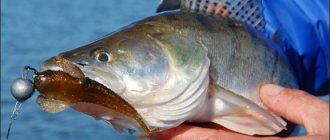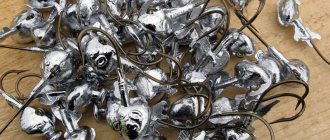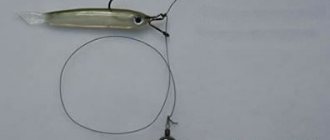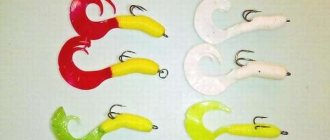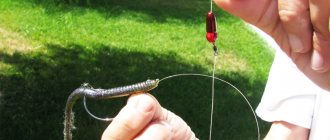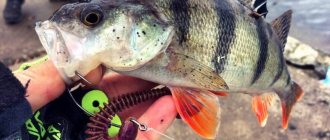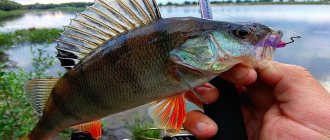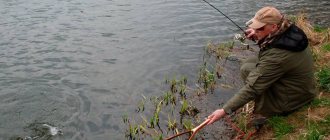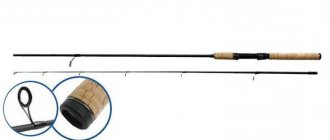What is a jig-rig
A jig rig is one of the types of mounting spinning equipment with silicone bait, designed for catching predatory fish.
This fishing equipment consists of an elongated sinker and an offset hook fastened together using connecting elements (this can be a winding ring, a swivel, a carabiner or a combination thereof). In addition to silicone bait, it is quite appropriate to use foam fish.
Where and when to apply
It is believed that this design was invented in the United States for catching largemouth bass (trout perch). Its use gave the bait increased permeability in dense thickets of bottom grass or in the crown of a flooded tree.
Unlike American inventors, who use jig-rigs only for fishing in reservoirs with thickets and snags, our fishermen also use this equipment for heavily silted bottoms, as well as on sandstone and shell rock.
It is worth noting that this type of installation is ideal for fishing from the shore in still water or at very low current speeds.
According to many reviews, the best time of year for jig-rig fishing is late autumn. At this time, fish accumulate in snags and holes, and a layer of fallen leaves forms at the bottom.
Silicone on a jig head or a hinged mounting on a Cheburashka collects the pricked leaves already at the beginning of the retrieve, but a jig-rig equipment (only when using an offset hook) allows you to avoid this, since only the end of the elongated sinker slides along the leaves.
What kind of fish can you catch?
It is not for nothing that the name of this type of installation uses the word “jig” in front: this immediately determines that the equipment is used for bottom fishing of any predatory fish. But since bass (trout perch) is not found in Russian reservoirs, for our spinners, jig-rig fishing involves catching pike, asp, pike perch, bersh, perch and catfish. Sometimes you come across chop, ruff, burbot, snakehead and even chub.
Installation of equipment
The classic version of this type of installation includes:
- elongated sinker with a loop;
- 2 winding rings;
- offset hook;
- silicone bait (usually a vibrotail).
An offset hook with a silicone bait attached and a sinker through the second winding ring are attached to the main winding ring, and a leash is also attached.
In addition to the classic version, spinning anglers also use other, slightly modified installation options:
- A cord, a silicone bait on an offset hook and a sinker on a swivel are attached to the central winding ring.
- Instead of a central winding ring, a leash with a carabiner attached to a cord is used, on which an offset hook with silicone and a weight on a swivel are put on.
It is very important that the hook is put on the fastener first, and then the sinker. While fishing, the pike shakes its head, and the clasp may come unfastened. If there is a sinker in front: it will rest against the carabiner and will not allow the hook to fly off. If it’s the other way around, the hook will turn out, slip off the clasp, and the trophy will be lost.
You can either do the installation yourself or purchase a ready-made one at a specialized fishing store, including on Aliexpress, which will be quite relevant for beginners.
Advantages and disadvantages of equipment
The main advantages of such a spinning installation include:
- High casting range;
- A predator-attracting game;
- Good passability through snags, grass thickets, and stone deposits;
- Possibility of playing on the spot;
- No tangles over the rod tip when casting;
- Simplicity, speed of installation.
We recommend reading: Catching burbot in winter using baitfish
The disadvantages of the classic variety of jig rig are:
- Difficulty in replacing sinkers and bait;
- The amplitude of oscillation of the twister or vibrating tail during wiring is lower than that of other spaced installations;
- The high cost of high-quality winding rings used in sport fishing tungsten sinkers.
Thus, a jig rig is an easy-to-assemble spinning rig with your own hands, which has a lot of advantages. Used in both sport and recreational fishing, it has a high catchability, allowing you to successfully catch a sedentary predator standing in the rubble of snags and grass thickets even in the lowest biting conditions.
Jig-rig fishing technique
Let's look at the features of spinning fishing using this equipment.
Selection of cargo and bait
The shape of the sinker can be different: teardrop-shaped, cone-shaped, multi-faceted or banana-shaped. You can also use drop shot sticks.
Photo: Weight for jig-rig, varieties
For everyday fishing, lead weights are suitable, but for competitions you can splurge on tungsten weights. They penetrate the wind better, and with the same weight they are 45% less in volume than lead ones.
About
Wiring for Tokyo and jig rig
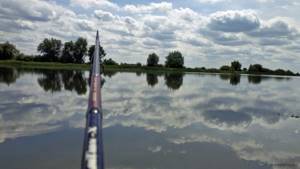
In short, the wiring of the Tokyo rig and jig rig is not much different from the classic jig. All the same techniques are used: step, short blasts with a rod, etc.
But there are also features:
If you drag the rig, thanks to a pull or an independent sinker, the bait will go above the bottom and work, but when pulling with a step, it works better on a pause. This can provide advantages when fishing on a cluttered, moss-covered bottom, and possibly in other conditions.
Watch some useful videos that can clarify many points in using jig rigs and Tokyo rigs:
Micro jig-rig
This method is used for catching small predators and even relatively peaceful fish; the size of silicone baits is limited to two to five cm, and the weight of weights is limited to one to six grams. Offset hooks and carabiners are also chosen in small sizes.
With the autumn cold, the water becomes more transparent, and the fish move further from the shore. In order to throw lightweight equipment for microjigging over a greater distance, the jig-rig type of installation is just right.
Since finding sinkers with a swivel for such micro equipment is problematic, craftsmen clamp a pellet sinker (1-2 g), sold in a set for fishing with a float, on one of the rings of a miniature swivel. Further installation is no different from a full-fledged jig-rig.
About
Fishing for pike on a jig-rig, equipment features
This type of rig is indispensable when catching this predator. Grass pike weighing 1-2 kg usually hide in thickets on shallow tables, and larger specimens prefer bottom rubble of stones and snags.
It is clear that to hunt a large predator you need the appropriate gear and equipment:
- a reliable rod (2.5-3 m) with a fast action blank and a test weight of at least 15 g;
- a multiplier or a spinning reel with a small gear ratio and a spool size of at least 3000;
- braided fishing line about 0.15 mm thick.
Photo: Jig-rig equipment for pike fishing
To install jig-rig equipment you will need:
- a semi-rigid (tungsten) or, ideally, a rigid (steel) Kevlar leash with a length of at least 40 cm (in case of a side attack or swallowing in pursuit, the cord will be cut off due to the small leash);
- winding rings, carabiners, swivels and offset hooks made of thick wire of the highest quality that can withstand maximum loads.
The size of silicone baits is selected depending on the expected size of the future trophy.
A big pike will not chase small fish. Therefore, to catch a predator weighing 3-5 kg, you need a silicone vibrating tail with a length of at least 12 cm, a sinker weighing at least 30 g and an offset hook of the appropriate size marked 3/0, 4/0 or 5/0.
I would like to note that, unlike perch, pike does not pay attention to “edible rubber” - it is more attracted to the play of the bait.
As can be seen from the article, this type of installation, like all others, in addition to its advantages, also has its disadvantages. It is important that the spinning player understands in what situations this equipment will show its best qualities, and in what situations its shortcomings can be eliminated by skillful wiring and selection of high-quality accessories.
Views: 734
Similar articles:
- Catching pike with stickbaits, walkers and poppers Many anglers are accustomed to the idea that pike invariably...
- Catching pike with a wobbler Pike is a voracious river predator, which can be fished all year round...
- Trolling pike. TOP 10 best wobblers for trolling for pike Pike, especially large ones, most often stay at depth, and to catch…
- Offset hook: types, sizes, selection, installation The success of any fishing depends not only on the skills of a skilled fisherman...
How to assemble a jig rig with your own hands
What you will need:
- Offset hook.
- A weight purchased in a store or cast yourself for a jig rig. Preferably, of course, with a built-in swivel. Increased mobility will not be superfluous. From fishing practice, I can ascertain that with or without a swivel, the fish are caught. It is necessary to have a loop on the load.
- Carabiner.
Following the original, it is recommended to install it through the winding ring. So the load does not become awry with the bundle.
As for the cargo, it can be cast directly while fishing. I made a hole in the ground with a twig. I twisted a pound out of a piece of paper. He stuck it in the hole. Carefully inserted a swivel into it and filled it with lead.
The weight of the cargo is selected depending on the characteristics of the reservoir - the strength of the current and depth.
Following the photo, it’s not difficult to do the installation of a jig rig yourself. It would be awkward to describe every movement. However, I want to draw your attention to one nuance. It concerns the situation when assembly is carried out on one carabiner, without the use of rings.
I don’t recommend making a connection like this.
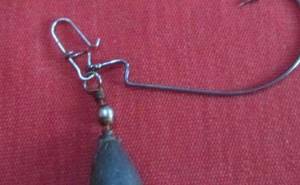
In this case, the end of the latch, when moving, interferes with the wiring in difficult places on the bottom. And filamentous algae will become permanent “passengers”.
It is more profitable to move the offset machine and the load to the opposite side of the carbine.
